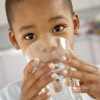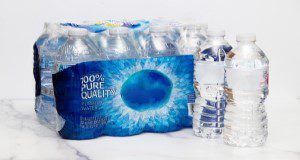Private well users are responsible for the management and protection of their wells. This new 4-page EDIS publication is for Florida homeowners who are interested in learning more about their well-water system and understanding how to properly shock, or disinfect, the well if there is evidence of drinking water contamination. Written by Yilin Zhuang and Mary Lusk, and published by the UF/IFAS Department of Soil and Water Sciences.
https://edis.ifas.ufl.edu/ss700
Tag: drinking water
Hydration Myths
 Whether at school, work, or running errands, it is common to see people sipping on their water bottles. This fashionable trend is a healthy one because water is essential for life. But while most people know that drinking water is good for them, many misconceptions exist about water and hydration. Learn the truth behind some of the most common hydration myths. This 4-page fact sheet was written by Lauren Caruso, Karla P. Shelnutt, and Gail Kauwell, and published by the UF Department of Family Youth and Community Sciences, August 2014.
Whether at school, work, or running errands, it is common to see people sipping on their water bottles. This fashionable trend is a healthy one because water is essential for life. But while most people know that drinking water is good for them, many misconceptions exist about water and hydration. Learn the truth behind some of the most common hydration myths. This 4-page fact sheet was written by Lauren Caruso, Karla P. Shelnutt, and Gail Kauwell, and published by the UF Department of Family Youth and Community Sciences, August 2014.
http://edis.ifas.ufl.edu/fy1409
Choose MyPlate: Drink Water Instead of Sugary Drinks (FCS80025/FY1358)
 The regular consumption of sugary drinks has greatly increased over the past few decades. Most adults consume about 400 calories per day as beverages, and regular soda is the number one drink. The added sugars and calories in sugary drinks can really add up — so rethink what you drink! Use one or more of the tips provided to drink more water and get on the right track to living a healthier life. This 3-page fact sheet was written by Jeanine Beatty, Karla Shelnutt, and Gail Kauwell, and published by the UF Department of Family Youth and Community Sciences, April 2013.
The regular consumption of sugary drinks has greatly increased over the past few decades. Most adults consume about 400 calories per day as beverages, and regular soda is the number one drink. The added sugars and calories in sugary drinks can really add up — so rethink what you drink! Use one or more of the tips provided to drink more water and get on the right track to living a healthier life. This 3-page fact sheet was written by Jeanine Beatty, Karla Shelnutt, and Gail Kauwell, and published by the UF Department of Family Youth and Community Sciences, April 2013.
http://edis.ifas.ufl.edu/fy1358
Hydration in Hot Working Environments (FCS80018/FY1325)
 Are you at risk for heat-related illnesses? Summertime isn’t the only time you should be concerned about drinking enough water to stay hydrated. Workers in construction, landscaping, laundry, factory, farm, or restaurant settings, among others, often are faced with hot working environments year-round. These conditions can increase the risk for developing heat-related illnesses, so staying well hydrated is very important. This 3-page fact sheet was written by Jeanine Beatty and Gail P. A. Kauwell, and published by the UF Department of Family Youth and Community Sciences, March 2012.
Are you at risk for heat-related illnesses? Summertime isn’t the only time you should be concerned about drinking enough water to stay hydrated. Workers in construction, landscaping, laundry, factory, farm, or restaurant settings, among others, often are faced with hot working environments year-round. These conditions can increase the risk for developing heat-related illnesses, so staying well hydrated is very important. This 3-page fact sheet was written by Jeanine Beatty and Gail P. A. Kauwell, and published by the UF Department of Family Youth and Community Sciences, March 2012.
http://edis.ifas.ufl.edu/fy1325
Where’s the Water? (FSHN1113/FS178)
Foods vary widely in water content. You may be surprised to find out that many common foods that are not liquids are quite high in water! This 5-page fact sheet offers a brief quiz and pictorial answer key, written by Wendy J. Dahl, and published by the UF Department of Food Science and Human Nutrition, May 2011.
http://edis.ifas.ufl.edu/fs178
¿Donde está el agua? (FSHN1113S/FS179)
Foods vary widely in water content. You may be surprised to find out that many common foods that are not liquids are quite high in water! This 5-page Spanish-language fact sheet offers a brief quiz and pictorial answer key, written by Wendy J. Dahl, and published by the UF Department of Food Science and Human Nutrition, May 2011.
http://edis.ifas.ufl.edu/fs179
FE843 Public Opinion about Drinking Water Issues in Florida
FE843, a 10-page illustrated report by Tatiana Borisova, John Brett, and Cassel Gardner, summarizes the results of a public survey about the drinking water issues in Florida. Published by the UF Department of Food and Resource Economics, October 2010.
http://edis.ifas.ufl.edu/fe843
FE851 Use, Perceptions, and Barriers to Water Conservation Strategies for Florida Water Utilities
FE851, an 18-page illustrated report by Shirish Rajbhanary, Tatiana Borisova, Damian Adams, Dwayne Haynes, and Chris Boyer, presents the results of a 2009–2010 survey of representatives of Florida’s drinking water systems to examine the relative use of conservation strategies by Florida water utilities. Includes references. Published by the UF Department of Food and Resource Economics, September 2010.
http://edis.ifas.ufl.edu/fe851
FCS8887/FY1138 Facts about Bottled Water
FCS8887, a 3-page illustrated fact sheet by Leila M. Kalley and Karla P. Shelnutt, addresses concerns about bottled water safety. Includes a list of recommended Web sites. Published by the UF Department of Family Youth and Community Sciences, February 2010.
http://edis.ifas.ufl.edu/fy1138
SL312/SS524 Drinking Water Source Protection in the Tampa Bay Region: A Guide for Government Officials
SS524, a 4-page fact sheet by Amy L. Shober, familiarizes government officials in the Tampa Bay Region with some of the regulatory and non-regulatory tools that can help to protect local sources of drinking water. Includes references. Published by the UF Department of Soil and Water Science, December 2009.
http://edis.ifas.ufl.edu/SS524
SL280/SS493 Drinking Water Source Protection in the Tampa Bay Region: A Guide for Homeowners
SL-280, a 3-page illustrated fact sheet by Amy L. Shober, familiarizes homeowners in the Tampa Bay region with the local sources of drinking water, potential pollution sources, and actions that can protect the quality of the local drinking water supply. Includes references. Published by the UF Department of Soil and Water Science, February 2009.
http://edis.ifas.ufl.edu/SS493
SL259/SS482 Indicator Organisms: What Every Floridian May Want to Know about Microbiological Water Quality
SL-259, a 3-page fact sheet by Max Teplitski and J. Dwain Butler, is designed to help the reader interpret the results of a microbiological water test. Includes references. Published by the UF Department of Soil and Water Sciences, March 2008.
http://edis.ifas.ufl.edu/SS482
SL259/SS482 Indicator Organisms: What Every Floridian May Want to Know about Microbiological Water Quality
SL-259, a 3-page fact sheet by Max Teplitski and J. Dwain Butler, helps homeowners interpret the results of a microbiological water test. Includes references. Published by the UF Department of Soil and Water Sciences, March 2008.
http://edis.ifas.ufl.edu/SS482
